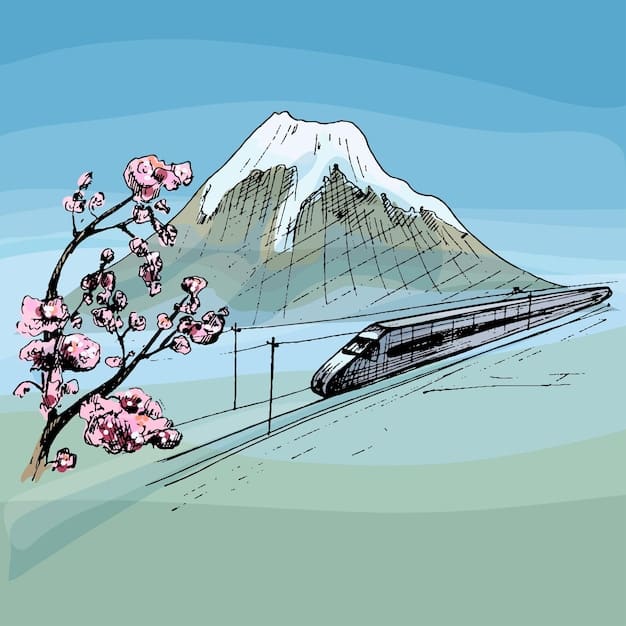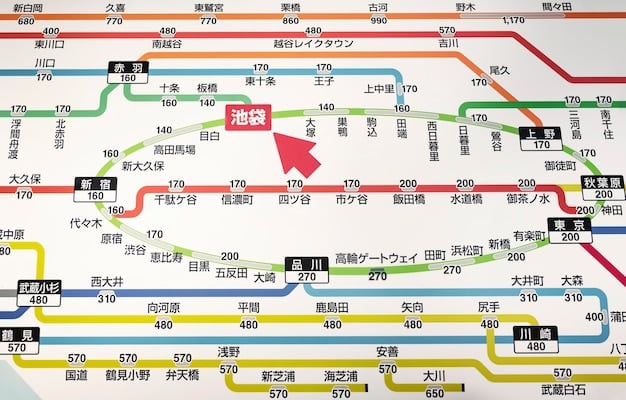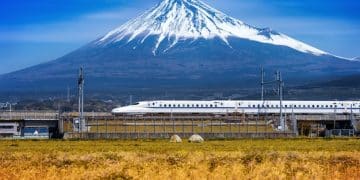Decoding Japan Rail Pass Options for US Tourists in 2025

Decoding Japan Rail Pass options for US tourists in 2025 involves understanding the different types of passes available, assessing travel itineraries to determine cost-effectiveness, and considering factors like travel duration and destinations to maximize savings and convenience.
Planning a trip to Japan in 2025? Navigating the country’s efficient and extensive rail network is a breeze with the Japan Rail Pass, but choosing the right one can be confusing. This guide focuses on decoding Japan Rail Pass options for US tourists in 2025: Which Pass Saves You the Most?, ensuring you make the most economical choice for your travel plans.
Understanding the Japan Rail Pass: An Overview for US Travelers
The Japan Rail Pass (JR Pass) is a cost-effective option for tourists planning to travel extensively across Japan using the Japan Railways (JR) network. It offers unlimited travel on JR trains, buses, and ferries for a fixed period. However, not everyone benefits from purchasing one, and understanding how it works is crucial.
The JR Pass is designed with foreign tourists in mind. It is not available to residents of Japan, and eligibility requires a temporary visitor visa. The pass comes in different durations, typically 7, 14, or 21 days, giving travelers flexibility to choose based on their itinerary.
Who Benefits from a Japan Rail Pass?
Whether a JR Pass is worth the investment depends heavily on your travel plans. Travelers who intend to visit multiple cities scattered across Japan are more likely to benefit than those staying primarily in one region.
- Extensive travel plans: Those visiting Tokyo, Kyoto, Osaka, and Hiroshima will likely save money with a JR Pass.
- Long-distance travel: Shinkansen (bullet train) tickets are expensive, and the pass covers these costs.
- Frequent train users: If you plan on using trains daily, the pass offers significant value.
Who Might Not Need a Japan Rail Pass?
Conversely, some travelers might find the JR Pass unnecessary or even more expensive than buying individual tickets.
- Staying in one city: If your trip is primarily focused on Tokyo or Osaka, local transportation cards may be more cost-effective.
- Regional travel: If you only plan to explore one region, consider regional passes that offer better value.
- Slow-paced travel: If you prefer slower, local trains or buses, the savings might not justify the pass’s cost.
Ultimately, the decision to buy a JR Pass should be based on a thorough analysis of your itinerary and associated transportation costs. Consider calculating the cost of individual tickets for your planned journeys and compare it to the price of the JR Pass to determine if it’s the right choice for you.

Different Types of Japan Rail Passes Available
The Japan Rail Pass isn’t a one-size-fits-all solution. Several options cater to different travel needs and budgets. Understanding the variations is vital to ensure you select the pass that offers the most value for your specific itinerary.
Two primary types of JR Passes are available: the Ordinary Pass and the Green Pass. The Green Pass offers first-class travel, providing more comfortable seating and less crowded carriages. However, it comes at a higher price, so it’s essential to weigh the benefits against the cost.
Ordinary Pass vs. Green Pass
The Ordinary Pass is the standard option, providing access to regular seating on all JR trains, buses, and ferries. It’s the more economical choice and suitable for most travelers.
- Ordinary Pass: Standard seating, suitable for budget-conscious travelers.
- Green Pass: First-class seating, offering more comfort and space.
Regional JR Passes
In addition to the nationwide JR Pass, regional passes cover specific areas of Japan. These can be more cost-effective if your travel is limited to a particular region.
- JR Hokkaido Rail Pass: Covers the Hokkaido region.
- JR East Pass: Covers eastern Japan, including Tokyo and surrounding areas.
- JR Kansai Wide Area Pass: Covers the Kansai region, including Osaka, Kyoto, and Nara.
Choosing the Right Pass
Selecting the correct pass involves assessing your travel itinerary and considering the cost of individual tickets versus the pass price. Regional passes often provide better value for focused travel within a specific area, while the nationwide pass is ideal for extensive, cross-country journeys.
Consider where you plan to travel and how frequently you’ll use the JR network. Compare the costs and benefits of each pass type to make an informed decision that aligns with your budget and travel style.
Calculating the Cost-Effectiveness of a Japan Rail Pass
Determining whether a Japan Rail Pass will save you money requires careful planning and a bit of math. It’s not simply about the number of days you’ll be traveling; it’s about the specific routes you plan to take and the cost of individual tickets.
The most effective way to calculate cost-effectiveness is to create a detailed itinerary and research the individual ticket prices for each leg of your journey. Compare the total cost of these tickets to the price of the JR Pass.
Step 1: Plan Your Itinerary
Start by outlining your travel destinations and the order in which you’ll visit them. Include specific train routes, bus routes, and any ferry trips you plan to take.
Step 2: Research Ticket Prices
Use websites like Japan-Guide.com or HyperDia to research the cost of individual tickets for each leg of your journey. Note the prices for both reserved and non-reserved seating, as well as any additional fees for express trains.
Step 3: Calculate Total Ticket Costs
Add up the individual ticket prices to determine the total cost of transportation without a JR Pass. Be sure to include any local transportation costs within cities, such as subway or bus fares.
Step 4: Compare with JR Pass Price
Compare the total cost of individual tickets with the price of the appropriate JR Pass. Consider the different durations (7, 14, or 21 days) and choose the pass that best aligns with your travel timeline.
Example Scenario
Let’s say you’re planning a 10-day trip that includes travel from Tokyo to Kyoto, then from Kyoto to Hiroshima, and finally back to Tokyo. The individual Shinkansen ticket prices might be:
- Tokyo to Kyoto: $130
- Kyoto to Hiroshima: $100
- Hiroshima to Tokyo: $150
- Total: $380
If a 7-day JR Pass costs $290, it would be a cost-effective option for this itinerary, even if you only use it for these three legs. However, if your itinerary includes less long-distance travel, the pass might not be worth it.

Hidden Costs and Considerations for Japan Rail Pass Holders
While the Japan Rail Pass can offer significant savings, it’s important to be aware of potential hidden costs and other considerations that might impact your overall travel budget and experience.
One common misconception is that the JR Pass covers all trains in Japan. It primarily covers JR-operated trains, but some private railway lines and local transportation within cities are not included. Additionally, certain high-speed Shinkansen trains, such as the Nozomi and Mizuho, require additional fees or are not covered at all.
Seat Reservations
While the JR Pass provides access to trains, seats on popular routes, especially during peak travel seasons, may require reservations. While seat reservations are free for JR Pass holders, they can take time and effort, especially if attempted last minute. You may need to visit a JR ticket office to secure your reservation.
Limited Validity
The JR Pass is valid for a specific number of consecutive days. If your travel plans are spread out over a longer period, the pass might not cover all your transportation needs. Carefully consider your itinerary to ensure the pass aligns with your travel dates.
Transportation to and from the Airport
Transportation to and from the airport is a crucial consideration. While the Narita Express is covered by the JR Pass, other airport transportation options, such as the Limousine Bus or private railway lines, are not. Factor in these costs when evaluating the overall cost-effectiveness of the pass.
Alternative Transportation Options
Sometimes, alternative transportation options, such as domestic flights or highway buses, can be more convenient or cost-effective than using the JR Pass. Consider all available options and compare prices before committing to the pass.
Being aware of these hidden costs and additional considerations will help you make a more informed decision about whether the Japan Rail Pass is the right choice for your travel plans. Thorough research and careful planning are essential to maximize savings and minimize unexpected expenses.
Maximizing Your Savings with a Japan Rail Pass
Once you’ve decided that a Japan Rail Pass is right for you, there are several strategies you can employ to maximize your savings and get the most out of your investment. Strategic planning and smart travel habits can make a significant difference in your overall travel experience.
One of the most effective ways to maximize savings is to plan your long-distance travel within the validity period of the pass. Consolidate your major train journeys into this timeframe to take full advantage of the unlimited travel benefits.
Combining with Local Transportation
While the JR Pass covers many routes, it doesn’t cover all local transportation. Consider purchasing a local transportation card, such as a Suica or Pasmo card, to cover subway and bus fares within cities.
- Suica/Pasmo cards: Convenient for local travel, accepted on most subways and buses.
- Day passes: Some cities offer day passes for unlimited local travel.
Taking Advantage of JR Buses and Ferries
The JR Pass isn’t limited to trains; it also covers certain JR buses and ferries. Explore these options to reach destinations not directly accessible by train.
- JR highway buses: Connect major cities and offer a more budget-friendly alternative to trains.
- JR ferries: Travel to islands and coastal destinations.
Traveling During Off-Peak Seasons
Traveling during off-peak seasons not only reduces crowds but can also lead to savings on accommodation and other travel expenses. Consider visiting Japan during the shoulder seasons (spring or fall) for a more affordable and enjoyable experience.
Utilizing Seat Reservations
Make seat reservations, especially during peak seasons, to ensure you have a guaranteed seat on your desired trains. This can save you time and stress, allowing you to enjoy your journey more fully.
By implementing these strategies, you can maximize your savings with a Japan Rail Pass and enjoy a more cost-effective and seamless travel experience. Careful planning and smart travel habits are key to making the most of your investment.
Japan Rail Pass in 2025: What to Expect
Looking ahead to 2025, several factors could impact the Japan Rail Pass and its value for US tourists. Staying informed about potential changes and trends will help you make the most informed decisions when planning your trip.
One key consideration is the potential for price increases. The JR Group periodically reviews the pricing of the Japan Rail Pass, and fluctuations in currency exchange rates and operational costs could lead to higher prices in the future. Keep an eye on official announcements for any updates.
Technological Advancements
Technological advancements could streamline the JR Pass experience, such as the introduction of digital passes or enhanced online reservation systems.
- Digital passes: Could eliminate the need for physical vouchers and simplify the redemption process.
- Online reservations: Easier online seat reservations, enhancing convenience for travelers.
Changes in Train Services
Changes in train services, such as the introduction of new Shinkansen lines or alterations to existing routes, could impact the overall value of the JR Pass.
- New Shinkansen lines: Increased accessibility to remote regions.
- Route alterations: Faster and more convenient travel between major cities.
Impact of Global Events
Global events, such as major sporting events or international conferences, could affect travel patterns and demand for the JR Pass. Be aware of any potential disruptions and plan accordingly.
Sustainable Travel
As sustainability becomes increasingly important, initiatives to promote environmentally friendly travel options could influence the JR Pass. This might include discounts or incentives for travelers who choose sustainable transportation options.
Staying informed about these potential changes will help you anticipate any challenges and opportunities when planning your trip to Japan in 2025. Keep an eye on official sources and travel advisories for the latest information.
| Key Point | Brief Description |
|---|---|
| 🚄 JR Pass Types | Ordinary, Green, and Regional passes cater to different travel needs. |
| 💰 Cost Calculation | Compare individual ticket prices with JR Pass cost for your itinerary. |
| 📅 Validity Period | Plan long-distance travel within the pass’s validity for max savings. |
| 🎫 Seat Reservations | Reservations are free, ensuring a seat, especially in peak seasons. |
Frequently Asked Questions
▼
It depends on your itinerary. If you plan to visit multiple cities with long-distance travel, even a short 7-day pass can be cost-effective compared to individual tickets.
▼
No, the JR Pass primarily covers trains operated by Japan Railways (JR). Some private railway lines and certain high-speed Shinkansen trains are not included.
▼
Purchase your exchange order at least a few weeks before your trip. You can exchange it for the actual pass once you arrive in Japan.
▼
Seat reservations are not mandatory, but they are highly recommended, especially during peak travel seasons, to ensure you have a guaranteed seat.
▼
Unfortunately, lost Japan Rail Passes cannot be replaced or refunded. It’s essential to keep your pass in a safe place throughout your travels.
Conclusion
In conclusion, decoding the Japan Rail Pass options for US tourists in 2025 requires careful consideration of your travel plans, budget, and potential hidden costs. By evaluating the different pass types, calculating cost-effectiveness, and staying informed about potential changes, you can make the most informed decision and enjoy a seamless and affordable travel experience in Japan.





